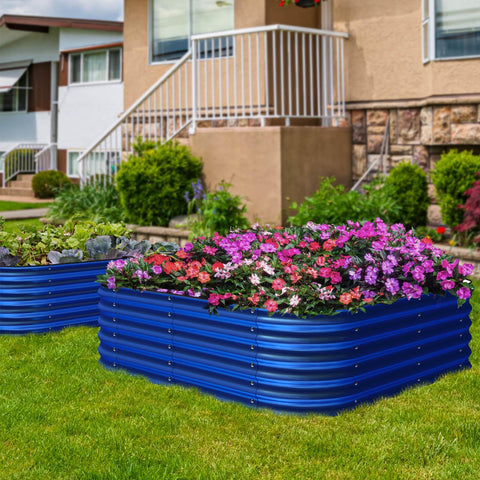The Green Thumb's Guide to Vegetable Gardening in Raised Garden beds
Are you eager to start your own vegetable garden but struggling with limited space, poor soil quality, or persistent pests? Look no further than raised bed gardening! This method offers a solution to a multitude of gardening challenges, making it a popular choice for both novice and experienced gardeners. In this article, we'll explore the world of vegetable gardening in Raised garden beds and discover why it's a fantastic way to cultivate your own fresh and delicious produce.
The Benefits of Raised Bed Gardening

Raised bed gardening involves creating elevated, contained gardens that are typically constructed from wood, stone, or other materials. There are numerous advantages to this gardening method:
a. Improved Soil Quality: Raised garden beds allow you to fill them with high-quality soil, free from the issues of poor drainage or compaction that can affect traditional garden plots.
b. Better Drainage: The raised nature of the beds ensures excellent drainage, reducing the risk of waterlogged roots and plant diseases.
c. Enhanced Pest Control: The Raised garden beds make it easier to protect your plants from pests and critters like slugs, snails, and rabbits.
d. Accessibility: Raised garden beds are a great option for gardeners with physical limitations as they require less bending and kneeling.
e. Extended Growing Season: The soil in Raised garden beds warms up faster in the spring and retains heat longer in the fall, extending your growing season.
Designing Your Raised Bed
Creating a successful raised bed garden starts with proper planning and design:
a. Choose the Right Location: Select a spot with at least 6-8 hours of sunlight daily for most vegetables.
b. Select the Right Materials: You can use wood, stone, concrete blocks, or even recycled materials to build your raised bed. Be sure to avoid treated lumber as it may contain harmful chemicals.
c. Size and Depth: Raised garden beds should typically be no wider than 4 feet to allow easy access from all sides, and the depth should be at least 6-12 inches.
d. Consider Pathways: Leave enough space between beds for pathways to make maintenance and harvesting more convenient.
Soil and Fertilization
The quality of the soil has a major impact on the success of your raised bed garden. Follow these steps to ensure your soil is nutrient-rich:
a. Use Quality Soil: Fill your raised bed with a mix of garden soil, compost, and organic matter to create a fertile, well-draining growing medium.
b. Regular Fertilization: Vegetables are heavy feeders, so supplement your soil with organic fertilizers to provide essential nutrients.
c. Soil Testing: Periodically test your soil to ensure the pH level and nutrient balance are optimal for your chosen crops.
Choosing Your Vegetables
When selecting vegetables for your raised bed, consider factors like plant size, sun requirements, and compatibility. Here are some popular choices for raised bed gardening:
a. Tomatoes: These sun-loving plants thrive in Raised garden beds and can be supported with stakes or cages.
b. Peppers: Bell peppers, chili peppers, and sweet peppers grow exceptionally well in Raised garden beds.
c. Leafy Greens: Lettuce, spinach, and kale are great choices, as they can be planted in close proximity.
d. Herbs: Plant herbs like basil, thyme, and oregano to complement your vegetable garden and repel pests.
e. Root Vegetables: Carrots, radishes, and beets do well in the loose, well-draining soil of Raised garden beds.
Maintenance and Care
Raised bed gardening doesn't require excessive maintenance, but you'll still need to tend to your garden regularly:
a. Watering: Raised garden beds can dry out more quickly, so keep a consistent watering schedule, typically in the morning to prevent fungal issues.
b. Weeding: Pull weeds as they appear to prevent them from taking over your garden.
c. Mulching: Apply mulch to help retain moisture, regulate temperature, and deter weeds.
d. Pest Control: Keep an eye out for pests and take appropriate action, such as using organic insecticides or physical barriers like row covers.

Conclusion
Vegetable gardening in Raised garden beds is an excellent way to overcome common gardening challenges while enjoying the satisfaction of growing your own fresh produce. With proper planning, design, and care, you can create a flourishing raised bed garden that provides you with bountiful harvests and a deep connection to the natural world. So, roll up your sleeves, grab your gardening tools, and get started on your raised bed garden adventure today!
